The 17th International Zurich Symposium and
Technical Exhibition on Electromagnetic Compatibility (EMC Zurich
in Singapore 2006) was held from February 27 to March 3, 2006
at the Singapore SUNTEC International Convention and Exhibition
Center. As it turned out, SUNTEC was a perfect location for this
event as it provided great meeting rooms, is situated adjacent
to the Central Business District of Singapore with ample hotel
space, and offered a variety of restaurants to please the taste
buds of participants. This was the first time that EMC Zurich
was organized outside Europe and Singapore was an excellent host
country that left a lasting impression on all participants.
The Symposium was one of the largest EMC events in the Asia-Pacific
Region jointly organized by the Singapore universities, the A-STAR
Institute, the IEEE EMC Singapore Chapter, the Institute of Engineers
Singapore, and in close cooperation with the Swiss Federal Institute
of Technology (ETH Zurich). The IEEE EMC Society as well as other
societies provided technical co-sponsorship. The general organization
of the Symposium followed the tradition of EMC Zurich with a clear
focus on high quality technical papers and their presentations
by speakers from all over the world. Two-day workshops and tutorials
prior to the Symposium were conducted by 36 international specialists
which introduced participants to the latest developments in the
fields of Lightning EMC, Semiconductor Device EMC, Circuit Board
EMC Design, Transportation EMC, EMC Modeling and Simulation, EMC
and Safety of Wireless Communication Devices, Naval Engineering
EMC, EMC and Signal Integrity, Shielding and Protection, as well
as System Level EMC Design and Control. These events alone were
well attended with over 220 participants and provided some groundwork
for the three days of regular EMC technical sessions to follow.
In addition, several topical meetings and special sessions took
place in the fields of Biomedical Electromagnetics, EMC in Asia,
Military EMC, Nanoelectronics EMC, and Wireless Communication
EMC.
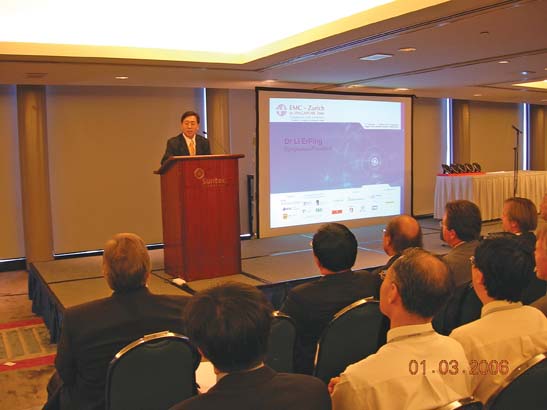 |
| The President of the Symposium, Dr.
Li Erping, giving the welcome address at the opening ceremony
on 1 March 2006. |
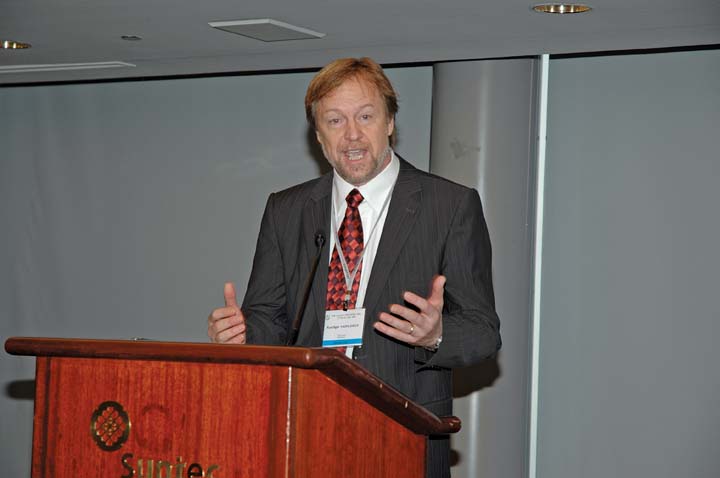 |
| The General Chair, Professor Ruediger
Vahldieck, addresses the audience at the opening ceremony. |
In conjunction with the Symposium two important meetings were
held: The IEEE Region 10 EMC Chapter Chairs Retreat and the Asia-Pacific
EMC Chairpersons Meeting. Both were well attended and provided
new information on the status of EMC activities in the Asia-Pacific
region. The Symposium attendance with 450 delegates from over
40 countries was slightly smaller than the 2005 EMC Zurich event
in Zurich with 550 participants, but was still significantly higher
than the organizers had anticipated. Also the exhibition, co-located
with the Symposium, had drawn over 35 exhibitors on 1000 square
meters of floor space.
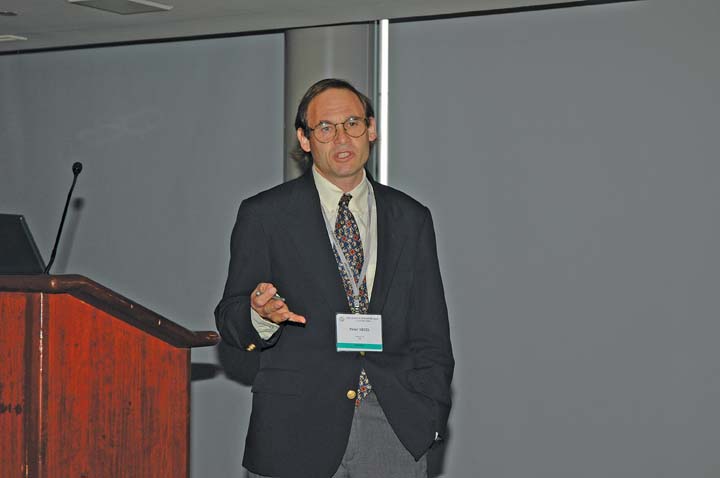 |
| Dr. Peter Siegel of the California
Institute of Technology, spoke on “Terahertz Technology
in Outer and Inner Space” during his keynote speech
at the Symposium opening session. |
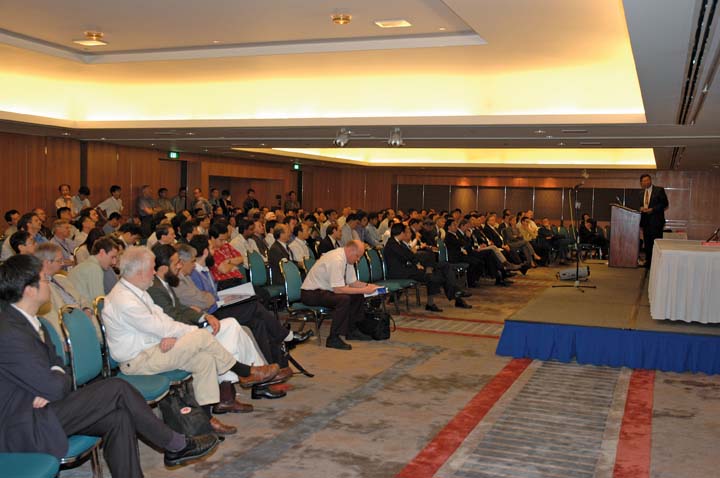 |
| Dr. C. K. Chou from Motorola presents
“The Potential of EMC in a Seamless Mobility Environment”
for his keynote speech at the Symposium opening session. |
In his speech during the opening ceremony on Wednesday morning,
Dr. Li Erping provided some background on the idea to move the
EMC Zurich Symposium in even years from Zurich to Singapore. He
described the organization of EMC Zurich in Singapore as difficult
at times and certainly interesting, but also as one of the most
challenging jobs he ever faced. In light of this, he felt relieved
when finally all the pieces of the work fell into place and the
Symposium ran smoothly. He thanked all the organizing committee
members for their great enthusiasm and hard work and emphasized
the fact that without their relentless effort, the Symposium would
not have been possible. On behalf of the organizing committee,
he also expressed his sincere thanks to the symposium sponsors
namely, Schaffer EMC Pte Ltd, Rohde & Schwarz, Singapore Technologies
Electronics Ltd, CST, EM Test, Swiss House Singapore and TME.
The General Chair, Professor Vahldieck, complimented the local
organizing committee for a job well done and announced that the
18th EMC Zurich Symposium will be held in Munich from September
24-28, 2007, at the same time of the world renowned Oktoberfest.
The Technical Program Chair, Professor Todd Hubing, outlined the
technical paper selection and review process. He pointed out that
the technical papers in Singapore maintained as high a standard
as known from Zurich and that about 30% of papers submitted were
rejected.
The Deputy-President of Nanyang Technological University, Professor
Er Meng Hwa, the Swiss Ambassador to Singapore, Dr. Daniel Woker,
and the President of the IEEE EMC Society, Dr. Andrew Drozd, welcomed
all participants in the name of their respective organizations.
The highlights during the opening session were two keynote speeches.
First, Dr. Peter Siegel, of the California Institute of Technology,
spoke on “Terahertz Technology in Outer and Inner Space”
and Dr. C. K. Chou spoke on behalf of Rob Shaddock, CTO for Mobile
Devices at Motorola Inc., on “The Potential of EMC in a
Seamless Mobility Environment.”
 |
| Professor Joungho Kim from KAIST,
Korea, presents his paper in Singapore. |
 |
| Professor and Mrs. Yoshino join Professor
and Mrs. Vahldieck at the reception held during the Symposium. |
The following three days offered 45 well attended technical sessions
and, in parallel, the Topical Meetings on concepts in Biomedical
EMC, Wireless Communication EMC, Nanoelectronics EMC, Automotive
EMC, and Semiconductor Device EMC.
In the evening following the first technical session on March
1, the delegates were invited to visit the Electromagnetic Environment
Research Lab (EMERL) located at the Nanyang Technological University,
which is a newly built EMC lab in Singapore. Delicious appetizers
were provided to the delegates prior to the lab tour. The delegates
enjoyed the reception food and the visit.
The Best Symposium Paper Award was given to Professor Stefano
Grivet-Talocia, Ms. Silvia Acquadro, Mr. Carlo Peraldo, Professor
Flavio Canavero, Dr. Ilkka Kelander, Dr. Markku Rouvala, and Dr.
Ali Arslan, all from the Politecnico di Torino, Italy, for their
paper “Parameterized Macromodels for Lossy Multiconductor
Transmission Lines.” This selection was from 169 regular
papers and 50 Topical Meeting papers reviewed by two to five independent
reviewers. From a short list of 10 papers the jury consisting
of Professor Youji Kotsuka, Dr. William Radasky, Professor Shen
Zhongxian, Professor Robert Weigel and Dr. Franz Schlagenhaufer,
selected the finalist. The jury commented that all the 10 short
listed papers were excellent and the decision was very difficult
to select just one. To expose the best Symposium papers to the
international community, all authors of accepted papers were invited
to submit an extended version of their paper to the IEEE Transactions
on EMC for a possible issue on EMC Zurich in Singapore to appear
at the end of 2006. However, the condition is that those papers
submitted must have a significantly extended content (about 60%)
over the Symposium paper and will go through yet another rigorous
review process after which only about 10 papers will be selected
for publication.
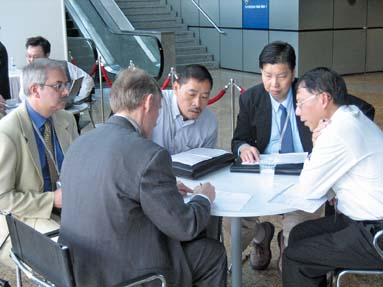 |
| The judges working on the best student
paper winners included, clock-wise from left, Professor Flavio
Canavero, Professor Peter Leung, Professor See Kye Yak, Dr.
Koh Wee Jin and Professor Todd Hubing (back to the camera). |
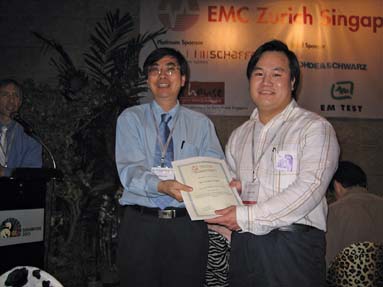 |
| The first place student prize winner,
Mr. Kezhong Zhao (left), receives the certificate from the
Technical Program Co-Chair Professor Ma Jianguo. |
The Best Student Paper competition was an equally difficult task
for the judges. Here, 21 papers were short listed from 58 student
papers. Besides the oral presentations, the students were required
to present their papers in the poster session. The jury consisting
of Professor Todd Hubing, Professor Peter Leung, Professor Flavio
Canavero, Professor See Kye Yak and Dr. Koh Wee Jin selected the
three best papers. The first prize went to Kezhong Zhao and Jin-Fa
Lee from Ohio State University for their paper “An Accelerated
Non-Conforming DP-FETI Domain Decomposition Method for the Analysis
of Large EMC Problems.” The second prize went to Stephan
Braun, Mohammed Al-Qedra, and Professor Peter Russer from the
Technische Universität München, Germany for the paper
“A Novel Real-time Time-domain EMI Measurement System Based
on Field Programmable Gate Arrays.” Mr. Kin Seong Leong
and his co-authors Mun Leng Ng and Professor Peter Cole from the
University of Adelaide, Australia, won the third prize for the
paper “Operational Considerations in Simulation and Deployment
of RFID Systems.” The associated prize money was 1000, 600,
and 400 Singapore dollars, respectively.
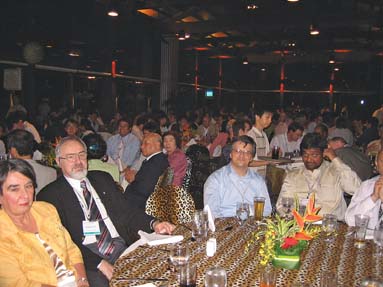 |
| An elaborate banquet dinner titled
“Singapore Night Safari” was held during the Symposium. |
The dinner banquet of the Symposium was specially held at the
world’s premier Singapore Night Safari (a night zoo). Creatures
from South America, Asia, and India greeted visitors from their
own naturalistic enclosures, which simulate that of their own
homeland. Even the tablecloths were decorated using the tiger
skin color.
In conjunction with the EMC Zurich in Singapore, the “Asia-Pacific
EMC Chairpersons Meeting” was held at Suntec City Singapore,
with the goal to address EMC collaboration, EMC enhancement, and
unification of EMC symposia in the Asia-Pacific region. The meeting
was well attended with EMC representatives from every major Asia-Pacific
region including Australia, China, Korea, Malaysia, Hong Kong,
Japan, Singapore and Thailand. Dr. Andrew Drozd, the President
of the IEEE EMC Society, Elya Joffe, the Vice-President for Member
Services of the IEEE EMC Society, as well as Professor Ruediger
Vahldieck, General Chair of EMC Zurich from ETH Zurich, Switzerland,
also attended the meeting. At the meeting, all agreed to start
planning for such an event with the goal to establish one united
Asia-Pacific Symposium on EMC that could be held every one or
two years moving from one Asian country to the next. A Steering
Committee was formed consisting of one representative from each
country or region. The first such Asia-Pacific Symposium on EMC
will be tentatively held in 2008. EMC
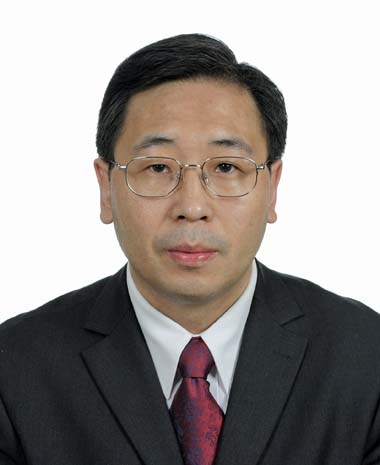 EMC
Week in Singapore: The 17th International Zurich
EMC
Week in Singapore: The 17th International Zurich 







